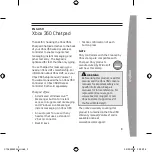
7
4) TECHNICAL DATA
Supply voltage
The actuators have been designed to operate at supply voltage of 3 AC 400 V / 50 Hz. However, they are
available in design variants operating at another three-phase AC supply voltage, upon special request. The supply
voltage of the electric motor should be within the tolerance limits of ±10 % of the rated value and the supply voltage
frequency should be within ±2 % of the rated value. Within this supply voltage range, all parameters are kept
up except the starting torque which varies with the square of the supply voltage deviation from the rated value.
This dependence is directly proportional to the supply voltage variation; no larger supply voltage and frequency
fluctuations are permitted.
Protective enclosure
Protective enclosure of actuators
MODACT MOED EEx
– IP 55 according to ČSN EN 60 529
Noise
Level of acoustic pressure A
max. 85 dB
(A)
Level of acoustic output A
max. 95 dB
(A)
Tripping torque
Tripping torque is set at the manufacturer according to the customer's requirements within the range given in Table
No. 1, 2. If setting of tripping torque is not required maximum tripping torque of the required type number of the electric
actuator is set.
Starting torque
The starting torque of the actuator is a calculated value determined by the starting torque of the electric motor and
the total gear ratio and efficiency of the actuator. After run reversation, the actuator can produce a starting torque for
the duration of 1 to 2 revolutions of the output shaft when torque-limit switching is locked. This can take place in either
end position or in any intermediate position.
Self-locking
The actuator is self-locking provided that the load only acts in the direction against motion of the actuator
output shaft. Self-locking is ensured by a roller arrest immobilizing the electric motor rotor even in the case of
manual control.
In order to observe safety regulations, the actuators cannot be used for driving transportation lifting devices with
possible transport of persons or for installations where persons can stand under the lifted load.
Sense of rotation
When looking at the output shaft in the direction towards the control box, the CLOSE direction of rotation is identical
with the clockwise sense.
Working stroke
The ranges of working stroke are given in Table No. 1 or No. 2.
Rising spindle
In the design variants with connecting dimensions, Shapes A and C, the actuators can be adapted for mounting
to the valve with a rising spindle that projects over the upper end of the actuator output shaft in the end position of the
valve. The space reserved for the rising spindle is clearly shown in the dimensional sketches. The user should mount
a cylindrical guard of the rising spindle instead of the port cover at the control box top, if required. This guard has not
been included in the delivery of the actuator.
Manual control
Manual control is performed directly by a handwheel
(without clutch).
It can be used even when the electric
motor is running
(the resulting motion of the output shaft is determined by the function of the differential gear).
When
the handwheel is rotated clockwise the output shaft of the actuator also rotates clockwise
(when looking at the shaft
towards the control box).
On condition that the valve nut is provided with left-hand thread, the actuator closes the
valve.
Содержание MODACT MO EE 52 120
Страница 2: ......
Страница 25: ...25 Terminal board of DMS2 Analog Terminal board of DMS2 Profbus...
Страница 49: ...NOTES...
Страница 50: ...NOTES...








































